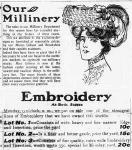You are here
Feathers, Ribbons and Bows: The Art of Making Hats
Many, many hours went into making a hat such as the one this lady is wearing. At this time, hat makers or milliners decorated their creations with feathers, fake and real flowers, berries, leaves, and even stuffed birds. Ladies would purchase a basic hat and the more accessories requested for the hat, the higher the price.
The demand for feathers or plumes for the millinery industry in the late 1880s until the early 1900s had disasterous consequences for birds all over the world. This led to the rise of the Audubon Society forming boycotts against the feather trade.
"A single 1892 order of feathers by a London dealer ... included 6,000 bird of paradise, 40,000 hummingbird and 360,000 various East Indian bird feathers. In 1902 an auction in London sold 1,608 30 ounce packages of heron ... plumes. Each ounce of plume required the use of four herons, therefore each package used the plumes of 120 herons, for a grand total of 192,960 herons killed."
By 1909, the feather trade began to decline with the Lacey Act which forbid the transportation of feathers across statelines. However, the plume or feather boycott movement led by society women, the very ones who once demanded feathers in their hats, eventually led to the passage of the Weeks-McLean Law in 1913, which permanently ended the wholesale slaughter of birds for their plummage. Smithsonian.

